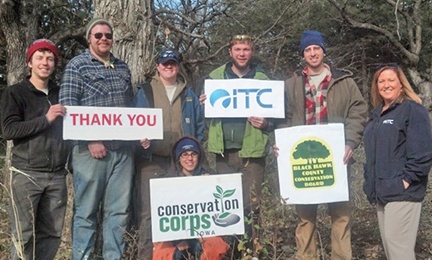Restoring Cedar Bend Savanna


Iowa corps members thank ITC for funding restoration work at Cedar Bend Savanna near Cedar Falls, Iowa. Standing, from the left are: Andrew Montgomery, Scott Cressler, Allison McIntosh, Ian Wolf and Josh Bruecken. On the right: Angela Jordan, ITC area manager, and in the front: Tracey Prenger, crew leader.
In November, Conservation Corps Iowa crews worked four weeks to clear invasive cedar trees and honeysuckle from the Cedar Bend Savanna in Black Hawk County. Restoration of the 55-acre black and bur oak savanna, located about four miles north of Cedar Falls, Iowa, will reduce erosion along the Cedar River, provide wildlife habitat, protect unique species such as the pasque flower and expand recreational opportunities such as hunting, hiking, bird watching and photography. Cedar trees cleared from the area are being recycled into fence posts by a local Amish community.
The Black Hawk County Conservation Board acquired Cedar Bend Savanna in 1985. However, staff didn’t have the resources to conduct major restoration work until 2012, when the ITC Charitable Fund provided a grant to Conservation Corps Iowa for the work and renewed support in 2013.
In the Midwest, only a small fraction of original oak savannas remain. Because of fire suppression, tree canopies have grown to cover up to 95 percent of savanna areas that should have only 10 to 50 percent oak cover. A healthy savanna protects an understory of native prairie, forest and savanna species, making the ecosystem more diverse than prairies or forests.